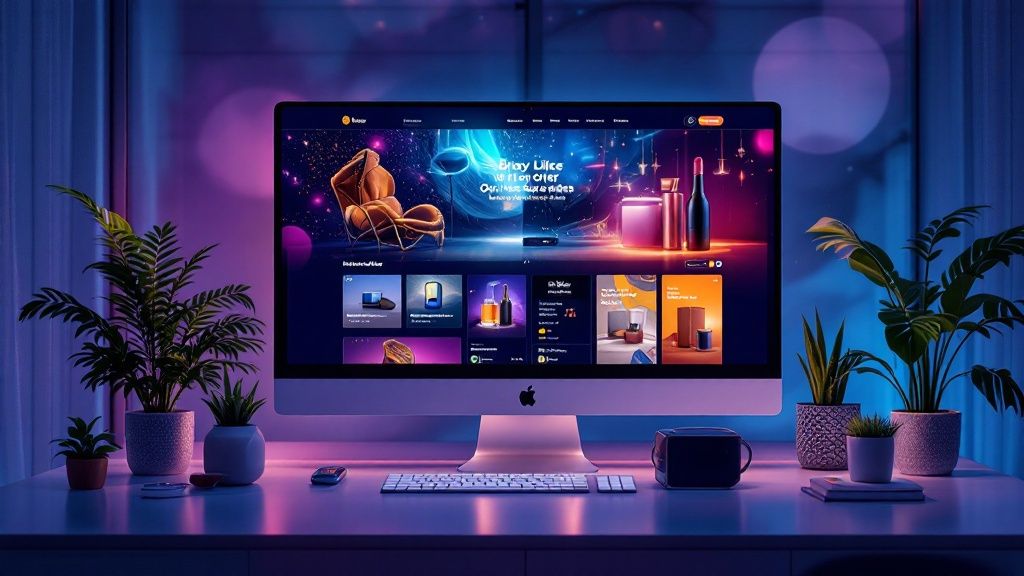How to Increase Ecommerce Sales: Expert Strategies That Drive Real Results
December 22, 2024

Mastering the Psychology of Flash Sales

Flash sales do more than just boost revenue – they tap into core consumer psychology to drive purchasing behavior. The real power lies in creating an irresistible sense of urgency and exclusivity that motivates customers to act fast. By understanding what truly drives your audience's buying decisions, you can design flash sales that resonate and convert.
The Power of Urgency and Scarcity
The psychology behind flash sales centers on the scarcity principle – people place higher value on things that are hard to get. Just think about concert tickets – when availability is limited, demand skyrockets as people rush to secure their spot. The same fear of missing out (FOMO) kicks in during flash sales. When products are only available for a short window or in small quantities, they become instantly more desirable. Smart ecommerce businesses harness this natural response to drive sales.
Building Anticipation and Excitement
The build-up to a flash sale is just as important as the sale itself. Rather than simply announcing discounts, create buzz through pre-sale marketing. Give sneak peeks of featured products and add countdown timers to your site. This works similarly to movie trailers – the anticipation creates desire and leads to higher engagement when the sale launches. The more excitement you generate beforehand, the better your sales will perform.
Structuring Your Flash Sale for Success
Creating a winning flash sale requires careful planning across multiple areas:
- Timing: Schedule your sale when your audience is most likely to shop, typically evenings and weekends. Align with existing shopping events to boost visibility.
- Promotion: Use various channels like email, social media, and influencer partnerships to spread the word widely.
- Messaging: Keep communications clear and focused on key benefits – highlight time limits, discounts, and special perks like free shipping. Simple, compelling messages help cut through the noise.
Analyzing Results and Refining Your Strategy
After each flash sale, examine key metrics to optimize future promotions and grow your ecommerce business. Track conversion rates, average order values, and customer acquisition costs. Pay attention to which products sold best and which marketing channels delivered the strongest results. For example, Charlotte Bio generated 17% of their monthly revenue in just 6 hours through a strategically planned flash sale. Their success shows what's possible when flash sales are executed thoughtfully. Use data from each sale to keep refining your approach and improving results over time.
Building a Mobile-First Shopping Experience
With smartphones becoming the primary way people shop online, creating an effective mobile experience is critical for growing ecommerce sales. Simply making your desktop site responsive on mobile screens is not enough to meet modern shoppers' needs. Let's explore what really drives mobile conversions and how to optimize the mobile shopping experience.
Rethinking Mobile for Higher Conversions
While responsive design is a good foundation, it often misses the unique context of mobile shoppers. Mobile users frequently browse while multitasking or on-the-go, with limited time and attention. They expect quick, frictionless experiences and will quickly abandon slow or complicated sites. Creating a mobile-first strategy means reimagining each step of the customer journey specifically for smartphone users – from product discovery through checkout.
Optimizing the Mobile Customer Journey
When designing for mobile, visual elements take priority. Large, crisp product images work best on small screens, with minimal text that's easy to scan. Features like infinite scroll create smooth browsing experiences as users swipe through products. Clear calls-to-action, like prominent "Add to Cart" buttons, help guide customers toward purchase. Think of it like arranging a physical store – the easier it is to browse and buy, the more sales you'll generate. This is especially true on mobile where screen space is limited.
The Power of Mobile Apps
While an optimized mobile website is essential, dedicated apps can drive even better results. Leading retailers see conversion rates three times higher in their apps versus mobile sites. Apps enable personalized experiences through features like saved preferences, push notifications for deals, and streamlined checkout with stored payment info. Though developing a quality app requires investment, the potential returns through increased sales and customer loyalty make it worth considering for serious ecommerce businesses.
From Browsing to Buying: Mobile Checkout Best Practices
The checkout process can make or break mobile sales. Research shows 27% of shoppers abandon purchases due to complicated checkouts. Simplifying this critical stage means minimizing required steps, offering guest checkout, and supporting mobile payment options. Features like auto-fill for shipping and billing information help customers complete purchases quickly. Just as long lines deter in-store shoppers, a clunky mobile checkout will cost you sales. Focus on reducing friction to boost your mobile conversion rates.
Crafting Email Campaigns That Actually Convert

Email marketing continues to be one of the most effective ways to connect with customers and boost sales. Going beyond basic newsletters, successful email campaigns focus on creating personalized messages that speak directly to customer needs and interests. The numbers back this up – email marketing generates $42 in revenue for every dollar spent, making it a smart investment for growing your business.
Building Relationships With Welcome Sequences
Just like greeting someone when they enter your store, the first impression you make through email matters. A thoughtfully designed welcome sequence helps turn new subscribers into loyal customers. Smart retailers use welcome emails to share their brand story, spotlight popular products, and offer special discounts that encourage first purchases. This approach clearly works – 58% of the top US online retailers have welcome email programs. By starting the relationship off right, you set the stage for ongoing engagement and sales.
Automating Success With Behavioral Triggers
To make email marketing work at scale, automation is essential. Setting up behavioral triggers lets you send perfectly timed, relevant messages based on how customers interact with your business. For example, when someone abandons their shopping cart, you can automatically remind them about those items and perhaps offer a small discount to complete the purchase. Or if someone browses winter coats, you can send them personalized recommendations for matching accessories. Studies show this type of targeted automation can increase revenue by up to 760% by creating email experiences that feel personal and helpful.
Segmentation and Personalization at Scale
Sending the same email to everyone is like putting up a "one size fits all" sign in your store – it rarely works well. Smart segmentation lets you group customers based on their demographics, purchase history, and browsing behavior so you can craft messages that resonate with each segment. For instance, you might send product recommendations to recent buyers based on their past purchases. Or create special campaigns for your VIP customers versus first-time buyers. For more ideas on boosting sales, check out our guide on ecommerce conversion optimization.
Measuring Your Email Marketing Success
To keep improving your email marketing, you need to track key metrics consistently. Keep an eye on open rates, click-through rates, conversion rates, and unsubscribe rates. This data shows you what's working and what needs adjustment. Just as you'd analyze sales data in a physical store, these metrics guide smart decisions about your email strategy. Regular monitoring and optimization ensures you get the best possible results from your email marketing investment.
Strategic Giveaways for Customer Acquisition

Running effective giveaways is one of the most powerful ways to grow your ecommerce sales and build lasting customer relationships. When done right, contests do more than just give away free products – they create genuine excitement and deliver measurable business results.
Why Giveaways Work
People naturally get excited about the chance to win something valuable at no cost. This basic psychology makes giveaways excellent for generating buzz and attracting potential customers who may not have found your brand otherwise. Beyond just attracting attention, giveaways provide a perfect opportunity to gather valuable customer data that you can use to create more targeted marketing campaigns and build stronger connections with your audience over time.
Choosing the Right Prize
The prize you select can make or break your giveaway's success. It needs to truly resonate with your target audience while reinforcing your brand identity. For example, an outdoor gear company would see better results giving away premium camping equipment or an adventure trip package rather than a generic gift card. One clothing retailer targeting young consumers ran a successful sneaker giveaway campaign that brought in 48,000 qualified leads. The key is picking prizes that your ideal customers genuinely want and that leave a lasting positive impression of your brand.
Designing Engaging Contest Mechanics
A great prize alone isn't enough – you need contest rules that encourage participation while serving your marketing goals. Make entering simple, but consider requiring actions like email signups, social follows, or referrals that help expand your reach. For instance, you might give participants extra entries for each friend they refer, motivating them to spread the word about your brand organically. Just be sure the entry requirements align with what you want to achieve.
Converting Participants Into Loyal Customers
The work continues after announcing the winners. The post-giveaway phase is crucial for turning participants into paying customers. Follow up with everyone who entered by thanking them for participating and offering a special discount or exclusive deal. This shows you value their engagement and encourages them to explore your products.
Here are some proven follow-up strategies:
- Personalized Emails: Send targeted messages based on how people engaged during the contest
- Exclusive Discounts: Give giveaway participants special pricing not available to others
- Product Recommendations: Suggest items related to the prize or their browsing habits
Take time to analyze your results, tracking metrics like participant numbers, site traffic, and sales conversions. This data reveals what resonated with your audience and helps optimize future giveaways. Each contest teaches you more about what drives engagement and sales with your specific customer base. Use these insights to keep improving your approach.
Adapting to Evolving Shopping Behaviors
Success in ecommerce requires a deep knowledge of how customers shop and what drives their purchasing decisions. Instead of just reacting to changes, businesses need to study emerging patterns and adapt proactively. This means closely monitoring shifts in behavior across the entire customer experience.
Understanding the Shift to Mobile
Mobile shopping has become the primary way many people buy online. This creates both opportunities and challenges for ecommerce businesses. While a poor mobile experience will frustrate customers and hurt sales, a smooth mobile journey can significantly boost revenue. Beyond just having a responsive website, businesses need to optimize every step specifically for mobile users – from product discovery to checkout. Key improvements include one-click purchasing, simple navigation, and mobile-friendly payment options.
The Rise of Social Commerce
Social media has grown from a marketing tool into a direct sales channel. Many customers now find and buy products without ever leaving their favorite social platforms. This makes social commerce an essential part of any ecommerce strategy. Rather than just sharing product photos, businesses can use shoppable posts, live shopping events, and partnerships with creators to make shopping more engaging. Meeting customers on the platforms they already use removes friction and makes purchasing more natural.
Meeting Elevated Customer Expectations
As online shopping becomes routine, customers expect more from the experience. Fast shipping, personalized recommendations, and excellent customer service are now baseline requirements. Successful businesses offer multiple shipping speeds including free options, suggest products based on browsing history, and provide quick support through live chat. These improvements not only drive immediate sales but also encourage customers to return.
Building Resilience Through Diversification
The ecommerce landscape changes constantly, so businesses must prepare for disruption. Having multiple sales channels builds stability and growth potential. Beyond your own website, consider selling through marketplaces like Amazon and Etsy, partnering with retailers, or expanding internationally. This reduces risk and opens up new customer segments. Tools like Checkout Links make it simple to create shoppable content across different platforms and adapt quickly as shopping habits change. A flexible, multi-channel approach positions your business for sustained success.
Implementation Guide and Performance Metrics

Turning ecommerce strategies into real results requires a clear plan for implementation and measurement. This section provides practical guidance on putting these strategies into action and tracking their impact on your business performance. The key is to set specific goals, select meaningful metrics, and use data to continuously improve your approach.
Defining Your Ecommerce Goals and KPIs
Start by getting crystal clear on what you want to achieve. Your goals might include increasing average order value, improving conversion rates, or expanding into new markets. Each goal needs its own set of Key Performance Indicators (KPIs). For instance, if you're focused on boosting average order value, track metrics like average revenue per user and items per transaction. For conversion rate improvement, monitor shopping cart abandonment and product page click-through rates. By choosing the right KPIs upfront, you can focus your efforts on what truly matters.
Building an Actionable Implementation Plan
After setting your KPIs, create a detailed plan that breaks down each strategy into specific, manageable steps with clear deadlines. Take a flash sale strategy as an example – your plan would include creating promotional materials, setting up email sequences, and configuring discount codes. This structured approach helps ensure nothing falls through the cracks. For more details on creating effective action plans, see our guide on improving your ecommerce sales with proven strategies.
Monitoring Performance and Making Adjustments
Getting started is just the beginning – you need to consistently track your chosen KPIs to understand what's working. Review your data regularly to spot trends and potential issues. For example, if you notice high cart abandonment, examine your checkout process for friction points. When marketing campaigns underperform, test different messaging or targeting. Making ongoing adjustments based on real data is essential for steady improvement.
Utilizing Tools and Technologies for Optimization
The right tools can make implementation and tracking much more effective. Project management software helps organize tasks and deadlines, while analytics platforms provide insights into customer behavior. A/B testing tools let you try different versions of your website and marketing materials to see what connects best with customers. For example, Checkout Links helps track shoppable link performance across platforms, showing exactly how well your links convert to sales.
Staying Agile and Adapting to Change
Markets and customer preferences change constantly, so flexibility is key to long-term success. Keep up with industry trends, test new approaches, and be ready to adjust your strategy when needed. Success comes from staying responsive to market changes while maintaining focus on your core business goals. Looking for more insights on adapting to changing shopping habits? Check out our previous section on Adapting to Evolving Shopping Behaviors.
Boost your Shopify store's sales with Checkout Links! Create shoppable links for seamless checkout experiences and watch your conversions soar. Start your free trial today and discover the power of streamlined shopping! Get Started Now!
 Checkout Links
Checkout Links



